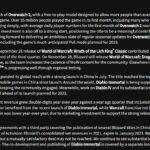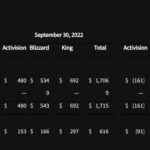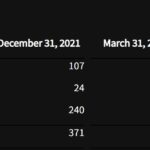
Welcome back to our trimonthly coverage of Activision-Blizzard’s quarterly financials. As of this afternoon, we have Q3’s results, comprising July, August, and September 2022. Analysts had pointed out that share values for the company are up thanks to the in-progress Microsoft buyout, but actual revenues have been in decline almost every quarter over the last two years (NASDAQ’s blog calls this “turbulence”), as we’ve been chronicling. Let’s break it down, first with ABK and then with Blizzard itself.
Activision-Blizzard on the whole saw a revenue drop of 14% this quarter compared to this same quarter last year, owing to what Bobby Kotick calls “reduced engagement for Call of Duty following the weaker reception for last year’s premium release.
“For the quarter ended September 30, 2022, Activision Blizzard’s net revenues presented in accordance with GAAP were $1.78 billion, as compared with $2.07 billion for the third quarter of 2021. GAAP net revenues from digital channels were $1.61 billion. GAAP operating margin was 27%. GAAP earnings per diluted share was $0.55, as compared with $0.82 for the third quarter of 2021. On a non-GAAP basis, Activision Blizzard’s operating margin was 34% and earnings per diluted share was $0.68, as compared with $0.89 for the third quarter of 2021. Activision Blizzard generated $257 million in operating cash flow for the quarter as compared with $521 million for the third quarter of 2021.”
Call of Duty Modern Warfare II did cross the $1B mark in global sales since its launch at the tail end of October, but those figures aren’t counted in this report, of course. Likewise, Overwatch 2 didn’t release until October and also can’t be counted here; Blizzard had touted 25M players since that release, but that’s apparently up to 35M now. Revenues should therefore “return to strong year-over-year growth in the fourth quarter following the successful launch of Modern Warfare II.” (The word “return” is loadbearing in this sentence since, uh, it’s been a while.)
King – the K in ABK – had a strong quarter as usual, with revenue up 6% YOY as “Candy Crush was the top-grossing game franchise in the U.S. app stores for the 21st quarter in a row.”
ABK Q2-22: $1.64B
ABK Q1-22: $1.77B
ABK Q4-21: $2.163B
ABK Q3-21: $2.07B
ABK Q2-21: $2.30B
ABK Q1-21: $2.28B
ABK Q4-20: $2.41B
ABK 2021: $8.80B
ABK 2020: $8.09B
Blizzard Q2-22: $401M
Blizzard Q1-22: $274M
Blizzard Q4-21: $419M
Blizzard Q3-21: $493M
Blizzard Q2-21: $433M
Blizzard Q1-21: $483M
Blizzard Q4-20: $579M
Blizzard 2021: $1.827B
Blizzard 2020: $1.905B
Blizz MAUs Q2-22: 27M
Blizz MAUs Q1-22: 22M
Blizz MAUs Q4-21: 24M
Blizz MAUs Q3-21: 26M
Blizz MAUS Q2-21: 26M
Blizz MAUs Q1-21: 27M
Blizz MAUs Q4-20: 29M
Blizz MAUs Q1-19: 32M
Blizz MAUs Q1-18: 38M
As for Blizzard itself, the report is much better: The company saw revenues of $543M, a 10% jump up compared to this quarter in 2021, and MAUs for the overall Blizzard segment were also up almost 15% since last quarter, bringing its collective playerbase back to 2020 numbers after its modern low point of 22M earlier this year. Again, Blizzard can’t count those 35M Overwatch 2 players or money yet, but the company does say that “the September 26 release of World of Warcraft: Wrath of the Lich King Classic contributed to a strong increase in WoW reach and engagement at the end of the third quarter” and WoW revenues are merely “stable.” The real winner appears to be the delayed launch of Diablo Immortal in China, where the game “reached the top of the download charts and has ranked in the top 10 grossing mobile games in China since launch.”
“Blizzard’s third quarter segment revenue grew double-digits year-over-year against a year ago quarter that included the release of Diablo II: ResurrectedTM. The third quarter benefited from the recent launch of Diablo Immortal, while Warcraft franchise net bookings were stable year-over-year. Segment operating margin was lower year-over-year, due to marketing investment to support the strong release slate and the shift in the mix of business in the quarter.”
All of this is excellent news for the beleaguered studio, which had been bleeding players up until last quarter and had one of its worst quarters for revenue ever early in 2022. However, Activision-Blizzard has a bit of an ominous note in the release hinting at troubles ahead with NetEase, which has been Blizzard’s Chinese partner for years. Back in August, we learned that at least one game, the Warcaft mobile title codename Neptune, had been scuppered over a Blizzard-NetEase dispute, so it’s possible we’ll see more fallout from these disagreements.
“Currently, we have licensing agreements with a third party covering the publication of several Blizzard titles in China. These agreements, which contributed approximately 3% of Activision Blizzard’s consolidated net revenues in 2021, expire in January 2023. We are in discussions regarding the renewal of these agreements, but a mutually-satisfactory deal may not be reached. We continue to see substantial long-term growth opportunities for our business in the country. The co-development and publishing of Diablo Immortal is covered by a separate long-term agreement.”
The MAU and financial effects of WoW Dragonflight and the Dragonflight prepatch won’t be realized until Q4. The press release also notes that Warcraft: Arclight Rumble is “progressing well through regional testing.”
Our running tally for your convenience:
38M in Q1 2018
37M in Q2 2018
37M in Q3 2018 (BFA)
35M in Q4 2018 (mass layoffs)
32M in Q1 2019
32M in Q2 2019
33M in Q3 2019 (WoW Classic)
32M in Q4 2019 (Blitzchung)
32M in Q1 2020 (COVID-19)
32M in Q2 2020 (COVID-19)
30M in Q3 2020 (COVID-19)
29M in Q4 2020 (COVID-19, Shadowlands)
27M in Q1 2021
26M in Q2 2021 (TBC Classic, WoW 9.1)
26M in Q3 2021 (D2R, lawsuits)
24M in Q4 2021 (Lawsuits, drought)
22M in Q1 2022 (Lawsuits, drought)
27M in Q2 2022 (Diablo Immortal)
31M in Q3 2022 (DI China, Wrath Classic)
As always, we note here that Blizzard intentionally reports MAUs this way to obfuscate which games are gaining and losing players, and traditionally it notes whenever a specific game has increased in MAUs. (It didn’t expressly do that here, though it did for Diablo Immortal last quarter.)
Activision-Blizzard hasn’t been “hosting a conference call, issuing an earnings presentation, or providing financial guidance” pending the Microsoft buyout, expected to complete summer 2023.
Here’s the full recap since 2015:
As longtime readers surely know, Activision-Blizzard, its leadership, and its games have been the subject of much-deserved criticism and scrutiny the last few years following an absolutely absurd list of scandals, including multiple rounds of mass layoffs, the Blitzchung boycott, C-suite payouts, shady stock deals/votes, abusive compensation, labor uprisings, a mass exodus of devs, plummeting playerbases, falling revenues, the ongoing sexual discrimination/harassment lawsuit, federal investigations, fired execs, destruction of evidence, workplace mismanagement, the strike, unionization attempts, unionbusting efforts, allegations against Bobby Kotick, stock drops, and the Microsoft buyout. On the gaming side, we’ve seen pipeline struggles, canceled BlizzCons, missed cadences, major delays and scope reduction, and of course the massive uproar over Diablo Immortal’s grotesque monetization.

















